

2021 WINNER

2021 Winner - Water Jetting Foot Valve Operation

An award providing opportunity for water industry operational staff to share their in the field innovations & fixes to problems so that others in the water industry can benefit.

Craig Woodhouse, TasWater
2021 Winner - Water Jetting Foot Valve
Craig Woodhouse, TasWater
Portable Powdered Batching Tank
Colin Ross, Gippsland Water
The Cracker Jack Eric Nielsen & Matthew Matusiak, Icon Water
Wagga Water Treatment Plant Provision of Wheelchair Access
Luke Prowse & Phillip McAlister, Riverina Water County Council
Portable Sodium Hypochlorite Dosing IBC Radar Level
Matthew Tarlinton & Steven Delchau, Icon Water
Sweeping the Problem Under the Rug (Pool Cover)
Scott Kitwood & Stephanie Badger, Gippsland Water
Previous Winners
2020 Scott Kitwood - Gippsland Water
2019 Toby Spark - Gippsland Water
2018 Michael Cartmer, Quinton Caird, Martin Zardins, Stephen Casey & Michael Dixon - Power & Water
2017 Marcus Boyd - Toowoomba Regional Council
2016 Daren Lord - TasWater
2015 Frank Rinaldo - North East Water
2014 Lester Little - TasWater
2013 Terry Randall & Danny Roberts - Port Macquarie Hastings Council
2012 Mark Walker - Gippsland Water
2011 Wayne Shaw - Gippsland Water
Objectives of the Award
• To create an opportunity which encourages water industry operational staff to share their in-the-field innovations and/or fixes to problems so that others in the water industry can benefit.
• To provide an application process which is easy to complete and utilises a standard template. This will give all water industry operational staff the same opportunity for presenting their innovation.
• To provide the opportunity for operational staff to receive recognition for their innovation and efforts.
• To encourage operational staff to become aware of and involved with the Water Industry Operators Association of Australia (WIOA).
• To allow WIOA to share the good ideas and innovations with other Members through the Operator magazine and/or other publications.
The Process
The PASS application template and more details on the Award can be found on the WIOA website www://wioa.org.au/awards/national-awards/pass-award/ or from the WIOA office.
Judging
All PASS applications received in the 12 month period ending 1st March annually, will be assessed by an independent panel on a number of criteria, including:
• Commonality of the problem
• Benefit to OH&S, water quality, and the environment
• Financial and sustainability benefits
• Application to other industries
• Uniqueness, adaptability and simplicity
Reward
The person who submits the PASS application deemed best in that particular year will be announced the winner of the PASS Award at the WIOA NSW Conference. Aqualift Pacific will provide sponsorship of $2,500 for the winner to join the WIOA team on their annual operational tour of New Zealand including attendance at the New Zealand WIOG operations conference.
Water Jetting Foot Valve Operation
Craig Woodhouse, TasWater
THE PROBLEM
What was the problem that you experienced?
The Australian Standard (AS) for high pressure water jetting machines has been updated and the TasWater water jetters that do not have the ability to be controlled remotely, no longer comply with the current standards.
When investigating, I became aware that it took two people to operate the water jetters. Communication between the two employees was difficult, especially when they were not in line of sight. Miscommunication was occurring and these issues increased the likelihood of an accident, possibly resulting in a severe injury.
TasWater owns and operates more than 15 jetting units and to replace them all with AS compliant machines would cost nearly $1.5M.
How did the problem impact you or your work?
Under the current situation, operators were not able to work within OH&S guidelines and were operating machinery that was not compliant with the current Australian Standards.
Within my job description, I am tasked with the supply and maintenance of equipment.
How long had the problem been occurring?
Since the change of standards for the operation of high pressure jetting machines
THE SOLUTION

How did you come up with the solution?
When assessing the situation, I realised that the communication issues could be eliminated if the operator, at the point of jetting, could have full control of the machine.
In light of the issues identified during my assessment, I developed a radio controlled foot peddle to enable the operator at the point of jetting to have full control. The operator is able to turn the water jetter on and off and if they fall or lift their foot, the machine shuts down. This allows it to also work as a dead man control.
Who helped work on the solution?
I put my ideas on paper and from there drew up a plan of the foot peddle. Then I contracted a manufacturer to have one built. I had it fitted and then demonstrated the foot peddle to senior TasWater staff for their approval. Once approved, the manufacturer was then contracted to make and then we had them fitted to all of TasWater’s water jetter units.
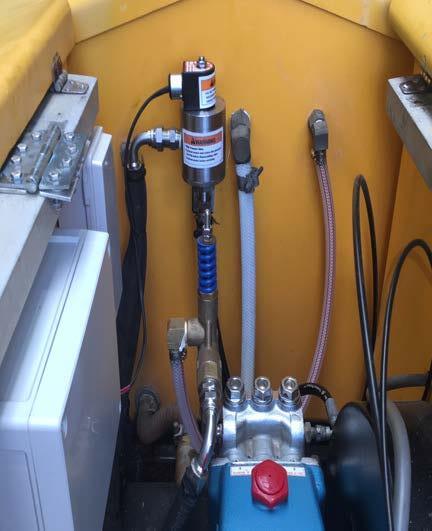

Describe the solution.
A radio-controlled foot valve that through a receiver and control box, supplies power to activate a high flow, high pressure stop solenoid. This in turn supplies water to the jetting hose while the peddle is depressed. If transmitting from the peddle is interrupted, or if the operator takes their foot off the peddle, water is then stopped and returns to the tank via an unloader valve.
This gives the operator full control over the highpressure water and allows the unit to be safely operated and controlled by the person cleaning the blockage. The unit also works as a shut off switch as if the operator loses their footing or releases pressure off the foot valve, the water is shut down.
The foot peddle now brings the high-pressure water jetters in line with the current Australian Standard.
How has it helped you at work?
The foot peddle has enabled me to contribute and maintain OH&S levels to the highest standard possible. It has enabled one person to complete the task that originally needed two people. It has also eliminated miscommunication issues that the employees were experiencing.
Suggest improvements, if time or financial limitations were not a factor.
I was given the funding to do the peddle operation at a high standard, so I don’t think we can improve it too much as we are using high quality components.
Any other comments you would like to make?
My innovation has allowed TasWater employees to now work with water jetters that meet Australian Standards.
It allows the operator to work individually with full control of the high-pressure water hose.
The foot pedals can be made in Tasmania at comparatively low cost and can be fitted to all existing jetter units.
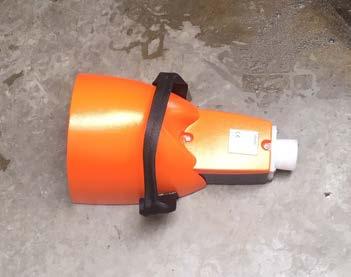
Foot Pedal Control Box
Remote E-Stop Box
Foot Pedal
Portable Powdered Batching Tank
Colin Ross, Gippsland Water
THE PROBLEM
What was the problem that you experienced?
Sulphuric acid 98% is used in the industrial treatment of the Gippsland Water Factory. Part of routine maintenance requires minor and controlled discharges of sulphuric acid inside the bulk storage bund (e.g. when inspecting dosing pumps, cleaning pressure relief valves). The contained acid is neutralised using powdered soda ash and then pumped back into the process.
Using powdered soda ash created a hazard as it would create an exothermic reaction inside the bund damaging assets and could be difficult to handle in windy conditions.
How did the problem impact you or your work situation?
The operators were required to manually handle the soda ash bags into position to be able to spread the powder and did not always dissolve into solution, causing additional clean up.
How long had the problem been occurring?
The issue of neutralising had occurred since the plant has been in operation (>10 years). The issue has been highlighted by the effects to the bund. Neutralising of the acid is required to make it safe to return to the process.
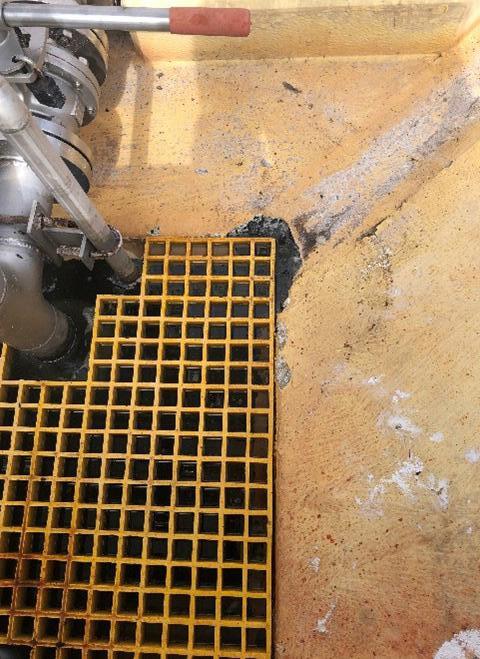
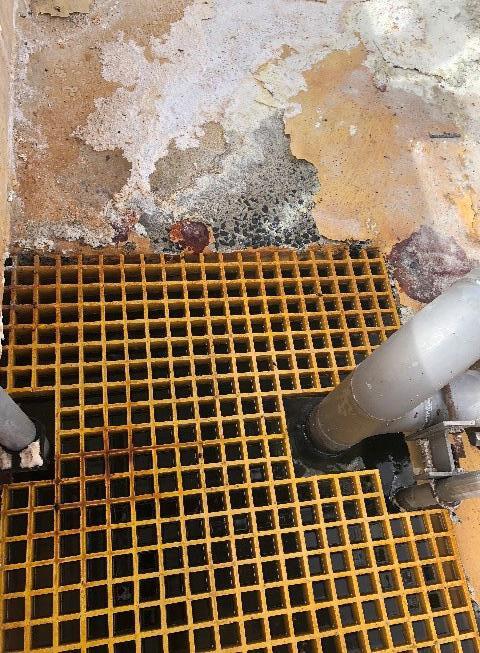
Powdered soda ash created a hazard as it would create an exothermic reaction inside the bund.
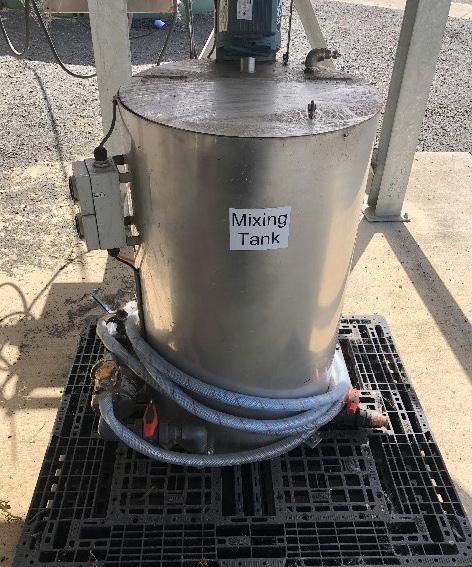
THE SOLUTION
How did you come up with the solution?
An informal white board session was held with the operational and maintenance team on-site. The idea of batching the powdered soda ash was discussed to make it safer and more controlled to use. However, there was the issue of not being able to use it in several locations. Thus, a portable batching tank was proposed.
The portable batching tank was designed and then fabricated on-site. It includes a small stainless still batching tank on a skid, with a pump to direct flow through a hose as required, and a mixer on the top.
The operational and maintenance staff trialled mixing in a bucket to ensure this would fulfil the application of neutralising the acid.
Who helped work on the solution?
The portable batching system was designed by collaboration between all the GWF Operators Team and the on-site Mechanical & Electrical Maintenance Team.

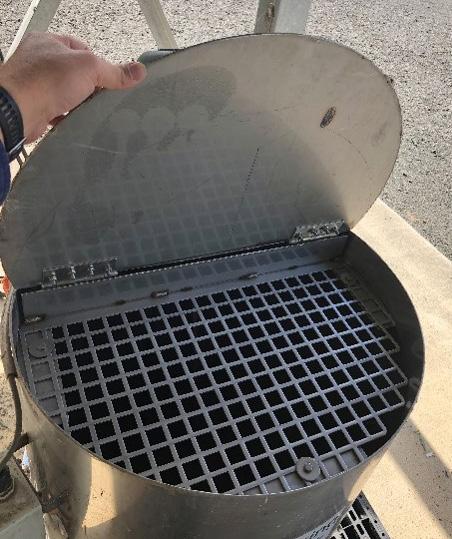
Describe the solution.
The solution is to pre-mix the dense soda ash powder in a mixing tank and use a pump to spray the areas that were affected by the acid. As there was no excess solid powder, no further clean-up was necessary resulting in less waste chemical as the solution could be held longer for more washing of hoses.
How has it helped you at work?
Less manual handling of soda ash bags, the liquid was able to come into contact easier than the powder form, time to neutralise the acid was reduced and less manual intervention by operators.
Suggest improvements, if time or financial limitations were not a factor.
If there was enough space in the required area, a larger tank installed to improve volume. A large style could also be used to batch other types of powdered chemicals such as sodium bicarbonate for maintenance of an ornamental pond on-site.
Any other comments you would like to make?
The use of a base to neutralise the acid does create heat, so the materials where neutralisation occurs must be made of an appropriate material. Selecting the correct acids and bases is critical as some reactions may produce harmful products.
The Cracker Jack
Eric Nielsen & Matthew Matusiak, Icon Water
THE PROBLEM
What was the problem that you experienced?
Lifting maintenance access covers is a high load high frequency task which is a likely contributor to musculoskeletal injury for workers.
How did the problem impact you or your work situation?
The problem of safely lifting access with the aim of minimising load on the user has not been well addressed. It is well understood that this is a serious issue for many utilities, other organisations and ultimately the end user.
How long had the problem been occurring?
Since manholes or maintenance access covers were first introduced to the market (100 years?)

THE SOLUTION
How did you come up with the solution?
Through design, development, and testing over a period of 1.5 years. Initially the first prototype was put together in one of the authors garages from a few pieces of angle iron, welded to a lead screw out of an old vice. This allowed for the concept of the jack driven by a drill to be proven. Other prototypes were developed as the solutions and ideas come along, some of them such as using a camera to inspect the inside of the manhole worked brilliantly, others not so. These were all tested and the pieces or concepts that worked were kept as part of the design and the others were not.
Who helped work on the solution?
A core group of people from diverse back grounds at Icon Water who believed in the project. These included operations and maintenance staff, as well as health and safety staff.
Describe the solution.
The Cracker Jack is a bespoke maintenance access cover lifting system which can directly reduce the risk of musculoskeletal injury to workers in the field who have to lift manhole covers. It weighs under 10 kg, can safely lift 500 kg and will work across all of the terrain types common to that of utilities.

How has it helped you at work?
Feedback from staff who use it is very positive. They consider it now the only way to lift gatic style lids.
Suggest improvements, if time or financial limitations were not a factor. Perhaps make it out of carbon fibre or titanium/ something ridiculous which would result in it weighing even less yet being stronger.
Any other comments you would like to make?
It is a great idea and can offer direct positive benefit to those who have to endure a life of lifting heavy lids. With the positive social benefit in mind, the design has been released under creative commons so that others can freely develop it or get them made at will.

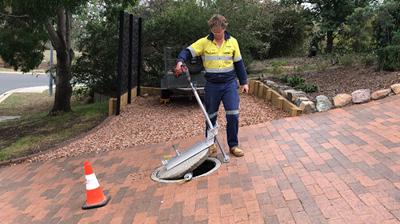
Lifter
Battery Drill
Roller Tube
Wagga Water Treatment Plant Provision of Wheelchair Access
Luke Prowse & Phillip McAlister, Riverina Water County Council

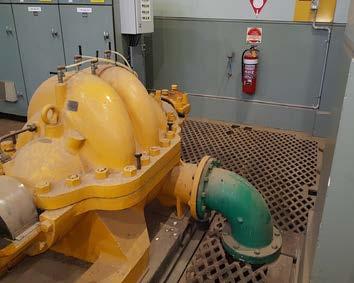
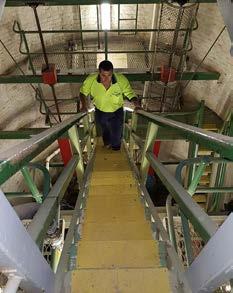
THE PROBLEM
What was the problem that you experienced?
Riverina Water’s previous Water Treatment Plant was built in the 1940’s, was duplicated in the 1950’s and did not consider handicap access i.e. access around the Water Treatment Plant consisted of a maze of stairs, ladders, narrow corridors, platforms and walkways. There was a perfect opportunity to rectify this with the concept and detail design of the new water treatment plant
How did the problem impact you or your work situation?
The various work teams at Riverina Water realised staff may be limited to perform their duties if afflicted by medical condition requiring wheel chairs (or other mobility aids).
Also, Riverina Water wanted to continue conducting public tour groups and did not want to limit persons based on their physically ability to negotiate stairs, steps and platforms etc.
How long had the problem been occurring?
As previously mentioned, the historical Water Treatment Plant (1940’s) did not consider access for wheel chairs or other mobility aids. It was accepted that those persons weren’t to be catered for.

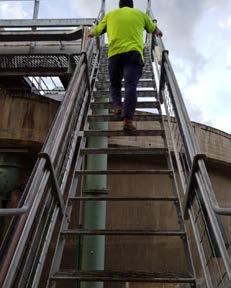
THE SOLUTION
How did you come up with the solution?
Consultation by the inhouse design teams with operations and other staff to improve access for operation and maintenance activities of the new water treatment plant led to further discussions about the opportunity to promote public tour groups to also visit the new water treatment plant. This led to Council approving the additional expense to install an elevator.
Who helped work on the solution?
Collaborative effort by: inhouse design team, operations teams (water treatment plant operators), trades, technicians, managers, Council Board.
Describe the solution.
Consultation during the concept design of the new water treatment plant included improved accessibility to operate, inspect, and maintain the various treatment processes and equipment.
The inclusion of an elevator required approval from Council to fund the additional cost. Council appreciated the benefits of having an elevator for staff and the public.
How has it helped you at work?
Our return-to-work programs for injured or recovering staff can include options for wheel chair access around the water treatment plant and control room.
Wheel chair access allows public tours to be conducted without disadvantaging people, and promotes Riverina Water as a progressive and modern organisation.
Suggest improvements, if time or financial limitations were not a factor.
Consideration to install similar access improvements at other water treatment plants when they are upgrade or replaced.


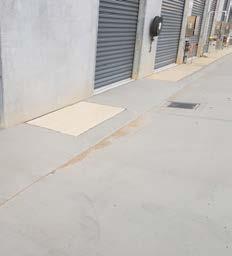
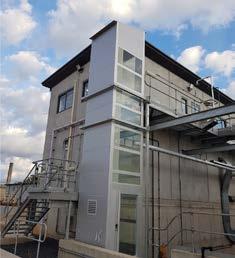

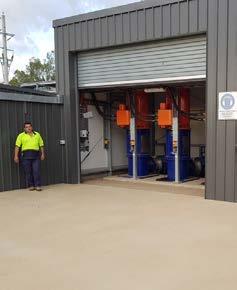
Portable Sodium Hypochlorite Dosing IBC Radar Level
Matthew Tarlinton & Steven Delchau, Icon Water
THE PROBLEM
What was the problem that you experienced?
Steven and I were asked to design build and commission an automated portable sodium hypochlorite dosing skid that could be controlled both remotely (by SCADA) and also locally for use when the gas chlorine system was offline for maintenance. During initial design phase it was identified that monitoring level of the associated IBC would be preferable during remote operation to ensure operations staff would have warning prior to IBC emptying.
How did the problem impact you or your work situation?
It impacted operational staff as they would need to continuously monitor IBC level locally to ensure that the system did not run out of the hypochlorite and cause breach of licensing.
How long had the problem been occurring?
Operations have not had oversight of IBC levels previously.
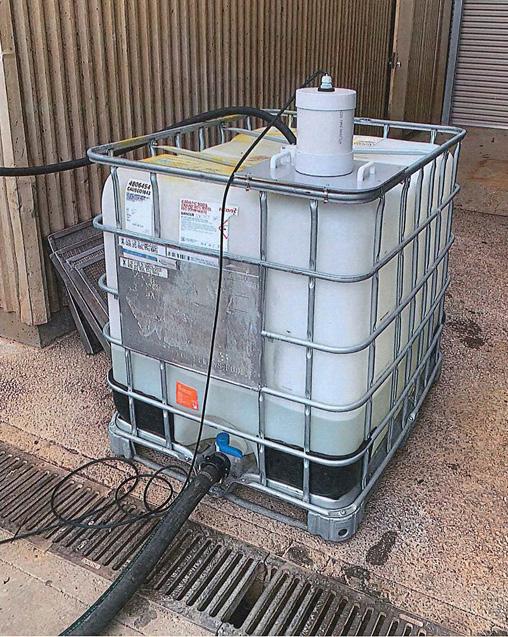

The Solution
How did you come up with the solution?
Use of radar was based on past experience where we had used radar level sensors to monitor levels through tops of fixed plastic tanks. The radar wave can easily pass through the plastic providing us with a safe and reliable non-contact level indicator. We then decided we needed to design a solution to allow easy monitoring of an IBC that an operator could simply clip on and clip off when changing to a new IBC. It needed to be rugged in construction to prevent damage to the radar unit if dropped and be constructed primarily of PVC to prevent reaction to sodium hypochlorite.
Who helped work on the solution?
The solution was constructed by Matthew Tarlinton and Steven Delchau.



Describe the solution.
The solution we decided upon was a clip radar level sensor mount made of nearly 100% PVC that could be moved from IBC to IBC without any tools in a matter of seconds. The unit would simply be plugged into the side of the control cubical allowing it to be removed and stored when not in use. It provides ease of use for operations and mechanical protection for the radar. The unit has been calibrated to work with IBC’s, so operations staff can simply plug it in and confirm the indication on the adjacent LCD panel matches the current IBC level and then return to control building where level can be monitored remotely.
How has it helped you at work?
It has helped operations staff as when using the system, they do not need to worry about the IBC running out of chlorine and effluent not receiving disinfection prior to being released to river. They are able to set configurable low and low, low level alarms to notify them that IBC needs to be changed.
Suggest improvements. If time or financial limitations were not a factor.
One improvement would be sourcing PVC clips to hold the unit to the IBC as the metal clip may be affected by the chlorine.




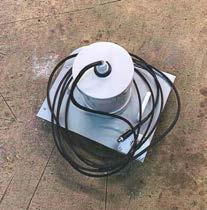

Sweeping the Problem Under the Rug (Pool Cover)
Scott Kitwood & Stephanie Badger, Gippsland Water
THE PROBLEM
What was the problem that you experienced?
Rawson WWTP has 3 upflow gravel filters as part of its treatment process and they are the last physical barrier to remove suspended solids before UV disinfection. Not only does the filtration process remove solids, it is an important step that removes pathogens like E. coli and other microorganisms. One of the main operational challenges is to keep the filters free of algal growth, which can be particularly hard in the summer months. With low flows and warmer weather, it provided the perfect conditions for algae to thrive.
How did the problem impact you or your work situation?
Algae can cause filter blockages, which reduce the performance of the filters and increases the need for routine operational maintenance. The filters operate in an online, standby (for high flows) & offline orientation. As the filter backwashing process at Rawson is done manually using a fire hose, it is quite labour and time intensive. The operator has to stand on top of the filter media, and wash the buildup of solids back through the filter which is then returned to the inlet works. Each filter needs to be washed three times before it is clean enough to be brought back into service. The operator then has to rake the filter media to level it out. This takes place over a few days, and has caused some manual handling strains to some operators. Algae can also dislodge and effect the downstream UV disinfection system, as well as contaminating the creek we discharge into.
How long had the problem been occurring?
This issue had been going on for years and seems to have been accepted by previous operators as routine and not given much thought. A short cut approach used was to avoid using the worse affected filter unless absolutely necessary.
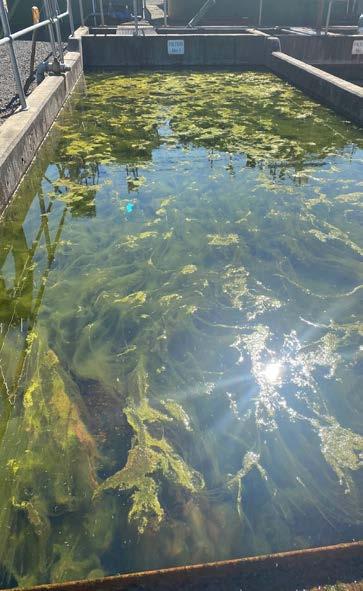
THE SOLUTION
How did you come up with the solution?
Given the physical requirements of manual backwashing process and seasonal conditions observed, I believed I could come up with an option to improve the backwash process and/or increase the filter runtimes. While in Clark Rubber collecting items for another project, I inquired about the concept of using a pool cover to block the sunlight and reduce the algal growth in the filters. I was presented with a few options and reported back to my supervisors with the information I had gathered.
Who helped work on the solution?
I consulted with management on what I believed to be the best product and measured up the filter for a custom fit cover. Following some staff movements, we were lucky enough to have Steph join our team. She was excited to continue the trial and helped with the installation and monitoring through two summer seasons.
Describe the solution.
The solution I went with was the Abgal Koolcover Pool Cover. The KoolCover offered all the benefits of a traditional solar blanket and ensured reduced heat transfer. A standard solar cover, which is more translucent, will absorb and reflect the suns rays into the water, heating it by around 8 degrees Celsius. The KoolCover is very opaque and shades the filter from direct sunlight, stopping the solar energy from penetrating the water. Sunlight is an important factor in controlling algae, as algae uses sunlight to convert carbon dioxide into cellular material. Increased growth rates can also be observed with increasing temperatures.
The insulative smartbubbles also help protect the water surface from wind and cold, and prevent evaporation by around 99%, all while being 20% flatter making it easier for manual handling.
How has it helped you at work?
After the initial install of the filter cover, the algae died off within 5 days. This was a much better result than expected, as we were only hoping we’d see a reduction, not a complete elimination! The filter was cleaned and put back into service, it has been in operation now for the past 10 months. Routine visual inspections are carried out daily, and since the installation of the filter cover there has been no algal growth detected. This means a reduced risk to changes in effluent quality caused by filter binding, and any algae that dislodges.
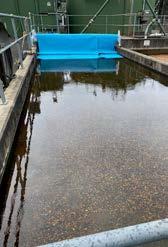
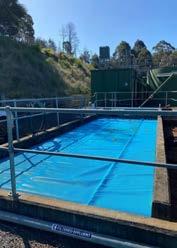

With the increased filter runtimes, backwashing requirements are now less frequent. This means less manual strain on the operator, and less backwash flow returning to the inlet works to be reprocessed. Manual checks show turbidity is consistent and the risk of carryover has been minimised. As there is no online instruments for turbidity or UVT, it provides great peace of mind knowing that the risks for turbidity breakthrough have been reduced thanks to the absence of algal growth. The UV lamps now need to be cleaned less often, and a higher UVT means better disinfection. From an environmental perspective, this minimises risk to Cooper’s Creek which the plant discharges into.
Suggest improvements, if time or financial limitations were not a factor.
Modifying the reel with a power tool attachment to allow for easier recall when retracting the cover to conduct inspections and/or routine cleaning. Installing 2 more filter covers or 1 that will cover all 3 filters.
Any other comments you would like to make?
This small change makes the wastewater operator’s life much easier and enables them to spend more time on system performance optimisation and other operational activities. The reduced manual effort required for backwashers is a huge OH&S benefit and a big time saver. Current trials are underway exploring further process improvements in hopes to remove the need for the second clarifier and potentially the filters in the future.


WIOA celebrates the sharing of good ideas by publishing all of the 2021 entries for the PASS Award. The authors, WIOA and Aqualift Project Delivery are not responsible for the outcomes of any actions taken on the basis of information in this document, nor for any errors or omissions. The authors, WIOA and Aqualift Project Delivery disclaim all and any liability to any person in respect of anything and the consequences of anything done or omitted to be done by a person in reliance upon the whole or any part of this document. If further expert advice is required the services of a professional should be sought.
